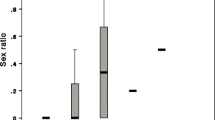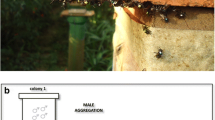Abstract
Trivers' and Willard's hypothesis that natural selection favors sex allocation in relation to maternal condition assumes iteropary. Though this assumption is not met in most solitary Aculeata, the reproductive life span of semelparous females may be divided into discrete successive cycles by the risk of open-cell parasitism. Females can avoid losing their investment to parasites attacking the open cell only by limiting the provision time for each cell. The restriction of time available for the investment in a single progeny irrespective of the condition of the female leads to de facto iteropary. Moreover, in Hymenoptera, there are no costs for sex allocation due to the haplodiploid mode of sex determination. In sexually size dimorphic species, females in poor condition are predicted to invest in the smaller sex and vice versa. The resulting prediction of a conditional sex allocation in solitary Aculeata was tested in the Red Mason bee, Osmia rufa (Osmia bicornis), a stem or hole-nesting, polylectic, univoltine megachilid bee. Body size is a key component of condition in females of nest-constructing solitary bees. Large females collect the same amount of pollen and nectar in a shorter time than small ones and should suffer less from parasitism. We found that small females dealt with their handicap of a low provisioning performance by shifting the sex ratio toward sons (the smaller sex) and by reducing the body size of daughters. Large females, however, shifted their offspring sex ratio toward daughters, the sex that depends more on body size in its reproductive value. The sex ratio in the population met the expected Fisherian sex ratio. Although females allocated their investment in the sexes according to their body mass, the population-level investment was balanced.






Similar content being viewed by others
References
Agresti A (2002) Categorical data analysis. Wiley series in probability and statistics, 2nd edn. Wiley, New York
Alcock J (1979) The relation between female body size and provisioning behavior in the bee Centris pallida. J Kansas Entomol Soc 52:623–632
Alcock J (1980) Natural selection and mating systems of solitary bees. Am Scientist 68:146–153
Alcock J (1990) Body size and territorial behavior in the bee Protoxaea gloriosa (Fox) (Hymenoptera: Oxaeidae). Pan-Pac Entomol 66:157–161
Alcock J, Eickwort GC, Eickwort KR (1977) The reproductive behavior of Anthidium maculosum (Hymenoptera: Megachilidae) and the evolutionary significance of multiple copulations by females. Behav Ecol Sociobiol 2:385–396
Bosch J (2008) Production of undersized offspring in a solitary bee. Anim Behav 75:809–816
Bosch J, Kemp WP (2004) Effect of pre-wintering and wintering temperature regimes on weight loss, survival, and emergence time in the mason bee Osmia cornuta (Hymenoptera: Megachilidae). Apidologie 35:469–479
Bosch J, Vicens N (2002) Body size as an estimator of production costs in a solitary bee. Ecol Entomol 27:129–137
Bosch J, Vicens N (2005) Sex allocation in the solitary bee Osmia cornuta: do females behave in agreement with Fisher’s theory? Behav Ecol Sociobiol 59:124–132
Bosch J, Vicens N (2006) Relationship between body size, provisioning rate, lengevity and reproductive success in females of the solitary bee Osmia cornuta. Behav Ecol Sociobiol 60:26–33
Brockmann HJ, Grafen A (1989) Mate conflict and male behaviour in a solitary wasp, Trypoxylon (Trypargilum) politum (Hymenoptera: Sphecidae). Anim Behav 37:232–255
Carranza F (2002) What did Trivers and Willard really predict? Anim Behav 63:F1–F3
Charnov EL (1982) The theory of sex allocation. Monographs in population biology. Princeton University Press, Princeton, p 18
Danforth BN (1990) Provisioning behavior and the estimation of investment ratios in a solitary bee, Calliopsis (Hypomarotera) persimilis (Cockerell) (Hymenoptera: Andrenidae). Behav Ecol Sociobiol 27:159–168
Danforth BN, Visscher PK (1993) Dynamics of a host–cleptoparasite relationship: Holcopasites ruthae as a parasite of Calliopsis pugionis (Hymenoptera: Anthophoridae, Andrenidae). Ann Entomol Soc Am 86:833–840
Fisher RA (1958) The genetical theory of natural selection, 2nd edn. Dover, New York
Frank SA (1995) Sex allocation in solitary bees and wasps. Am Nat 146:316–323
Freeman BE (1981a) Parental investment, maternal size and population dynamics of a solitary wasp. Am Nat 117:357–362
Freeman BE (1981b) Parental investment and its ecological consequences in the solitary wasp Sceliphron assimile (Dahlbohm) (Sphecidae). Behav Ecol Sociobiol 9:261–268
Frohlich DR, Tepedino VJ (1986) Sex ratio, parental investment, and interparent variability in nesting success in a solitary bee. Evolution 40:142–151
Gerber HS, Klostermeyer EC (1970) Sex control by bees: a voluntary act of sex fertilization during oviposition. Science 167:82–84
Helms KR (1994) Sexual size dimorphism and sex ratios in bees and wasps. Am Nat 143:418–434
Holm SN (1973) Osmia rufa L. (Hym. Megachilidae) as a pollinator of plants in greenhouses. Ent Scand 4:217–224
Ivanov SP (2006) The nesting of Osmia rufa (L.) (Hymenoptera, Megachilidae) in the Crimea: structure and composition of nests. Entomol Rev 86:524–533
Johnson MD (1988) The relationship of provision weight to adult weight and sex ratio in the solitary bee Ceratina calcarata. Ecol Entomol 13:165–170
Kenward MG, Roger JH (1997) Small sample inference for fixed effects from restricted maximum likelihood. Biometrics 53:983–997
Kim J-Y (1997) Female size and fitness in the leaf-cutter bee Megachile apicalis. Ecol Entomol 22:275–282
Kim J-Y (1999) Influence of resource level on maternal investment in a leaf-cutter bee (Hymenoptera: Megachilidae). Behav Ecol 10:552–556
Kim J-Y, Thorp RW (2001) Maternal investment and size-number trade-off in a bee, Megachile apicalis, in seasonal environments. Oecologia 126:451–456
Klostermeyer EC, Mech SJ, Rasmussen WB (1973) Sex and weight of Megachile rotundata (Hymenoptera: Megachilidae) progeny associated with provision weights. J Kans Entomol Soc 46:536–548
Krombein KV (1967) Trap-nesting wasps and bees: life histories, nests, and associates. Smithonian, Washington
Krunić M, Stanisavljević L, Pinzauti M, Felicioli A (2005) The accompanying fauna of Osmia cornuta and Osmia rufa and effective measures of protection. Bull Insect 58:141–152
Larsson FK (1990) Female body size relationships with fecundity and egg size in two solitary species of fossorial Hymenoptera (Colletidae and Sphecidae). Entomol Generalis 15:167–171
Leimar O (1996) Life-history analysis of the Trivers and Willard sex-ratio problem. Behav Ecol 7:316–325
Maddocks R, Paulus HF (1987) Quantitative Aspekte der Brutbiologie von Osmia rufa L. und Osmia cornuta Latr. (Hymenoptera, Megachilidae): Eine vergleichende Untersuchung zu Mechanismen der Konkurrenzminderung zweier nahverwandter Bienenarten. Zool Jahrb, Abt System, Ökol Geogr Tiere 114:15–44
Marshall DJ, Bonduriansky R, Bussière LF (2008) Offspring size variation within broods as a bet-hedging strategy in unpredictable environments. Ecology 89:2506–2517
Molumby A (1997) Why make daughters larger? Maternal sex-allocation and sex-dependent selection for body size in a mass-provisioning wasp, Trypoxylon politum. Behav Ecol 8:279–287
O'Neill KM (1983) The significance of body size in territorial interactions of male beewolves (Hymenoptera: Sphecidae). Can J Zool 63:2187–2193
O'Neill KM, Evans HE, O'Neill RP (1989) Phenotypic correlates of mating success in the sand wasp Bembecinus quinquespinosus (Hymenoptera: Sphecidae). Can J Zool 67:2557–2568
Peruquetti RC, Del Lama MA (2003) Sex allocation and sex-dependent selection for body size in Trypoxylon rogenhoferi Kohl (Hymenoptera, Sphecidae). Rev Bras Entomol 47:581–588
Peterson JH, Roitberg BD (2006) Impacts of flight distance on sex ratio and resource allocation to offspring in the leafcutter bee, Megachile rotundata. Behav Ecol Sociobiol 59:589–596
Phillips JK, Klostermeyer EC (1978) Nesting behavior of Osmia lignaria propinqua Cresson, (Hymenoptera: Megachilidae). J Kansas Entomol Soc 51:91–108
Piepho HP, Möhring J (2006) Selection in cultivar trials—is it ignorable? Crop Sci 46:192–201
Raw A (1972) The biology of the solitary bee Osmia rufa (L.) (Megachilidae). Trans R Ent Soc Lond 124:213–229
Rosenheim JA, Nonacs P, Mangel M (1996) Sex ratios and multifaceted parental investment. Am Nat 148:501–535
SAS Institute Inc (2008) SAS/STAT 9.2 user’s guide. Cary
Seidelmann K (1990) Zur Parasitenkontrolle in Stammzuchten der Roten Mauerbiene Osmia rufa (L.). Wiss Z M-Luther-Univ Halle-Wittenberg, Math-Naturwiss R 39:25–34
Seidelmann K (1995) Untersuchungen zur Reproduktionsbiologie der Roten Mauerbiene, Osmia rufa (L., 1758) (Dissertation). M.-Luther-Universität, Halle
Seidelmann K (1999) The race for females: the mating system of the red mason bee, Osmia rufa (L.) (Hymenoptera: Megachilidae). J Insect Behav 12:13–25
Seidelmann K (2006) Open-cell parasitism shapes maternal investment patterns in the Red Mason bee Osmia rufa. Behav Ecol 17:839–848
Severinghaus LL, Kurtak BH, Eickwort GC (1981) The reproductive behavior of Anthidium manicatum (Hymenoptera: Megachilidae) and the significance of size for territorial males. Behav Ecol Sociobiol 9:51–58
Smith CC, Fretwell SD (1974) The optimal balance between size and number of offspring. Am Nat 108:499–506
Strickler K (1982) Parental investment per offspring by a specialist bee: does it change seasonally? Evolution 36:1098–1100
Strohm E (2000) Factors affecting body size and fat content in a digger wasp. Oecologia 123:184–191
Strohm E, Linsenmair KE (1997a) Female size affects provisioning and sex allocation in a digger wasp. Anim Behav 54:23–34
Strohm E, Linsenmair KE (1997b) Low resource availability causes extremely male-biased investment ratios in the European beewolf, Philanthus triangulum F. (Hymenoptera, Specidae). Proc R Soc Lond B 264:423–429
Strohm E, Daniels H, Warmers C, Stoll C (2002) Nest provisioning and a possible cost of reproduction in the megachilid bee Osmia rufa studied by a new observation method. Ethol Ecol Evol 14:255–268
Stubblefield JW, Seger J (1994) Sexual dimorphism in the Hymenoptera. In: Short RV, Balaban E (eds) The differences between the sexes. Cambridge University Press, Cambridge, pp 71–103
Sugiura N (1991) Male territoriality and mating tactics in the woolcarder bee, Anthidium septemspinosum Lepeletier (Hymenoptera: Megachilidae). J Ethol 9:95–103
Sugiura N, Maeta Y (1989) Parental investment and offspring sex ratio in a solitary mason bee, Osmia cornifrons (Radoszkowski) (Hymenoptera, Megachilidae). Japan J Entomol 57:861–875
Tasei J-N (1973) Le comportement de nidification chez Osmia (Osmia) cornuta Latr. et Osmia (Osmia) rufa L. (Hymenoptera Megachilidae). Apidologie 4:195–225
Tepedino VJ, Torchio PF (1982) Phenotypic variability in nesting success among Osmia lignaria propinqua females in a glasshouse environment (Hymenoptera: Megachilidae). Ecol Entomol 7:453–462
Tepedino VJ, Torchio PF (1989) The influence of nest-hole selection on sex ratio and progeny size in Osmia lignaria propinqua (Hymenoptera: Megachilidae). Ann Entomol Soc Am 82:355–360
Thornhill R, Alcock J (1983) The evolution of insect mating systems. Harvard University Press, Cambridge
Tomkins JL, Simmons LW, Alcock J (2001) Brood-provisioning strategies in Dawson's burrowing bee, Amegilla dawsoni (Hymenoptera: Anthophorini). Behav Ecol Sociobiol 50:81–89
Torchio PF, Tepedino VJ (1980) Sex ratio, body size and seasonality in a solitary bee, Osmia lignaria propinqua Cresson (Hymenoptera: Megachilidae). Evolution 34:993–1003
Trivers RL, Willard DE (1973) Natural selection of parental ability to vary the sex ratio of offspring. Science 179:90–92
Ulbrich K, Seidelmann K (2001) Modeling population dynamics of solitary bees in relation to habitat quality. Web Ecology 2:57–64
Wcislo WT, Minckley RL, Spangler HC (1992) Pre-copulatory courtship behavior in a solitary bee, Nomia triangulifera Vachal (Hymenoptera: Halictidae). Apidologie 23:431–442
Acknowledgments
We are very grateful to H. Ruhnke for her assistance in the field work. We wish to thank Bryan Danforth and anonymous reviewers for their comments on the manuscript. This work was supported by a grant from the Helmholtz-Zentrum für Umweltforschung—UFZ.
Author information
Authors and Affiliations
Corresponding author
Additional information
Communicated by O. Rueppell
Rights and permissions
About this article
Cite this article
Seidelmann, K., Ulbrich, K. & Mielenz, N. Conditional sex allocation in the Red Mason bee, Osmia rufa . Behav Ecol Sociobiol 64, 337–347 (2010). https://doi.org/10.1007/s00265-009-0850-2
Received:
Revised:
Accepted:
Published:
Issue Date:
DOI: https://doi.org/10.1007/s00265-009-0850-2




